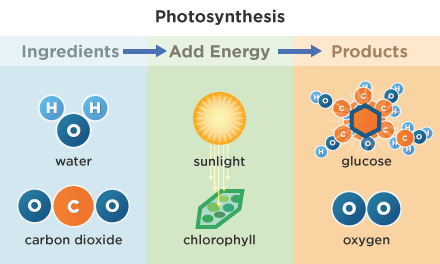Directions
Hungry for more about carbs? We get most of our energy from eating carbs, and the carbs we eat mostly come from plants. For example, the wheat plant is an important source of carbs. The wheat is ground into flour, and flour is made into bread, pasta, and other foods. Now where do the carbs in wheat come from?
The answer is photosynthesis!
Plants make carbs—specifically, glucose—by capturing the light energy from the sun to transform water (H₂O) and carbon dioxide (CO₂) into oxygen (O₂), and glucose (C₆H₁₂O₆), a monosaccharide. This process is called photosynthesis.
The plants then break down, or digest, that glucose for energy to survive. Plants also use these glucose molecules to build more complex carbohydrates such as starch and fiber. Plants use starch to store energy, and the tough fiber provides structural support for the roots, stems, and leaves.

